By Ellen Park
Natalia Mendez often does double duty as chef and hostess at her Oaxacan restaurant, La Morada, located in the Mott Haven neighborhood of the South Bronx. Mendez, 44, opened the 10-table restaurant five years ago to bring authentic Oaxacan cuisine to New York.
New York residents have long complained of the lack of quality Mexican food compared with cities like San Francisco or Los Angeles. But that may change with a growing tide of Mexican immigrants, like Mendez, who seek to retain the flavors of home. Over the last 10 years, the Mexican-born population in the five boroughs has increased by 52%, more rapidly than any other immigrant group, to 186,000 residents. According to a recent report from the Department of City Planning, Mexicans are now the third largest immigrant group in New York after Chinese and Dominicans.
While the highest concentration of foreign-born Mexicans is in Corona, Queens, followed by Brooklyn’s Bushwick neighborhood, the Bronx showed the most rapid growth of all boroughs, at 102%, compared with Queens at 65% and Brooklyn at 26%.
For Mendez and her family, La Morada is more than just a business. The world “morada” means both dwelling and purple in Spanish, and the walls of the restaurant are painted a deep purple. A telenovela on Univision plays on a large wall-mounted TV screen near the front door, near a yellow sign that reads, “Village Voice Choice Eats.” The air is thick with the fragrance of garlic, spices and grilled meat.
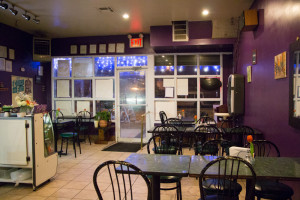
The interior of La Morada restaurant in the Mott Haven neighborhood of the South Bronx. Morada means both “dwelling” and “purple” in Spanish.
“I don’t see this as a restaurant,” said Yajaira, Mendez’s oldest daughter. “Just dining in my own house. Our customers know who we are and come into talk about their problems or what’s going on in the neighborhood. It’s a safe place for everybody. It doesn’t matter who you are.”
La Morada is a family affair. Mendez does much of the cooking with help from her husband, Antonio Saavedra, who works the grill. Yajaira, 25, studied marketing at CUNY and handles much of the restaurant promotion. Their 23-year-old son, Marco, helps out as host and waiter when he’s not working at the Northern Manhattan Coalition for Immigrant Rights. The youngest, Erica, 20, is the only sibling born in the U.S. but is the one who enjoys cooking the most.
Saavedra was the first in the family to come the U.S. after the 1985 Mexico City earthquake caused his small grocery store to falter, and he needed to earn money to send back to Mexico. Mendez followed a few years later with dreams of opening a clothing boutique. She was good at sewing and found a job in a factory in Manhattan’s Garment District, but gradually those jobs moved overseas.
“The factories were replaced by restaurants,” said Mendez. “But I was bothered by the quality of the food. They called themselves authentic and charged high prices.”
Mendez decided it was time to open her own restaurant, one that offered healthy, affordable meals and focused on Oaxacan food culture.
When they began scouting locations, they found one in downtown Manhattan and their current location in the Bronx. But with the 2008 economic downturn, they opted for the more economical Bronx. Mendez and Saavedra had a growing number of Mexican friends in the borough and liked the idea of increasing traffic to the South Bronx, a neighborhood often associated with high crime and the “Bronx is burning” era of the 1970’s, when whole blocks were lost to fires, whether from arson or poor building conditions.
Mendez and her family saw the restaurant as a chance to contribute to the neighborhood from the inside out, and the family prides itself on their diverse clientele. On a weekday afternoon, the customers ranged from Mexican to black to Puerto Rican to white. Mendez counts the city’s diversity as her favorite thing about living in New York.
“The whole world is New York,” said Mendez.” I can walk down the block and see African dancers and then Ecuadorian dancers on the next.”
Mendez sees the Bronx’ evolving diversity as a positive.
“Different types of cultures can bring us closer and allow us to grow as a community,” said Mendez.
A sense of culture and community was an important part of Mendez’s childhood while growing up in San Miguel Ahuehuetitlán in the Mixteca region of Oaxaca, a state in the southwestern part of Mexico known for retaining its indigenous culture. Its geography separates it from the northern states that were quickly colonized by the Spanish. According to Mendez, Oaxacan cuisine tends to use more vegetables than other states, due to an abundant rainy season as well as a less developed economy. Recipes are handed down through generations and from cooking together with members of the village community.
In her book “The Food and Life of Oaxaca,” Mexican-born restaurateur Zarela Martinez writes that “the concept of offerings still resonates everywhere in Oaxacan life.” Food holds symbolic significance as a process of sharing and exchange.
Mendez proudly says that La Morada is the only authentically Oaxacan restaurant in New York – while many Mexican restaurants in New York offer one kind of mole, the menu at La Morada features five different moles: Poblano (chocolate), Verde (green chile and jalapenos), Negro (black chiles), Oaxaqueño (spicy with seven different kinds of peppers), and Pepian (pumpkin seed). She also serves the lesser-known “Mole blanco,” a creamy mole made from ground pine nuts. Since mole is a time-consuming process, Mendez advises customers to call ahead if they are seeking a specific kind of mole. Generally two of the five varieties are offered on any given day.
Everything is made by hand using traditional methods. Adorning the counters separating the kitchen from the dining area are several molacajete bowls in which Mendez grinds spices and other ingredients by hand. One mole can take four to six hours from start to finish, but in an interview translated by one of her daughters, Mendez explains that time is crucial to ensure the quality and flavor of her dishes. For now, Mendez makes the mole by herself to ensure consistency.
“Food is life,” Mendez said. “Food is also a form of activism.”
For the Mendez family, activism extends from food to their identity as immigrants. Marco participated in a self-deportation last summer to raise awareness on immigration reform. Save for Erica, who was born in the U.S., the family has unauthorized immigration status.
“We’re very open with our status,” said Yajira. “My mom always taught us to speak up. Regarding immigration, a lot of people enjoy our Mexican food and culture. Why are we not accepted then? We’re here to work. We’re helping the economy grow by giving people jobs and paying taxes from our restaurant.”
Yajaira moved to the U.S. when she was four years old, but recalls that cooking gave the village a reason to come together, as preparation could be labor intensive.
“We would gather together as a community and cook together,” Yajaira said. “Our dishes were made with the whole neighborhood.”
Yajaira says that she and her brother Marco leave the cooking to their sister Erica but retain their culture through other means.
“I don’t know how to cook,” said Yajaira.” But I know the language and speak it fluently. That’s my way of preserving culture. Their struggle is my struggle.”
In the evening, Erica rushes into La Morada straight from her job teaching children’s swimming classes. Dressed in faded jeans and a purple t-shirt, she looks like other New Yorkers in their 20’s except with some added flair: Her hair is dyed magenta and and her nails are painted several different colors. While cooking she stands next to her mother in a traditional Mexican blouse, white with embroidered with flowers and leaves. Yajaira says that Erica keeps the tradition of Oaxacan cooking alive.
“It’s also because of her that we are inspired to keep our dishes very traditional,” Yajaira said.
But the menu features Erica’s more contemporary influence as well.
“She’s also a very healthy eater. So we have a vegetarian and a vegan section for healthy eating,” Yajaira said. “That was her idea.”
Tags: la morada, Mexican, mole blanco, mott haven, oaxacan, south bronx, tradition
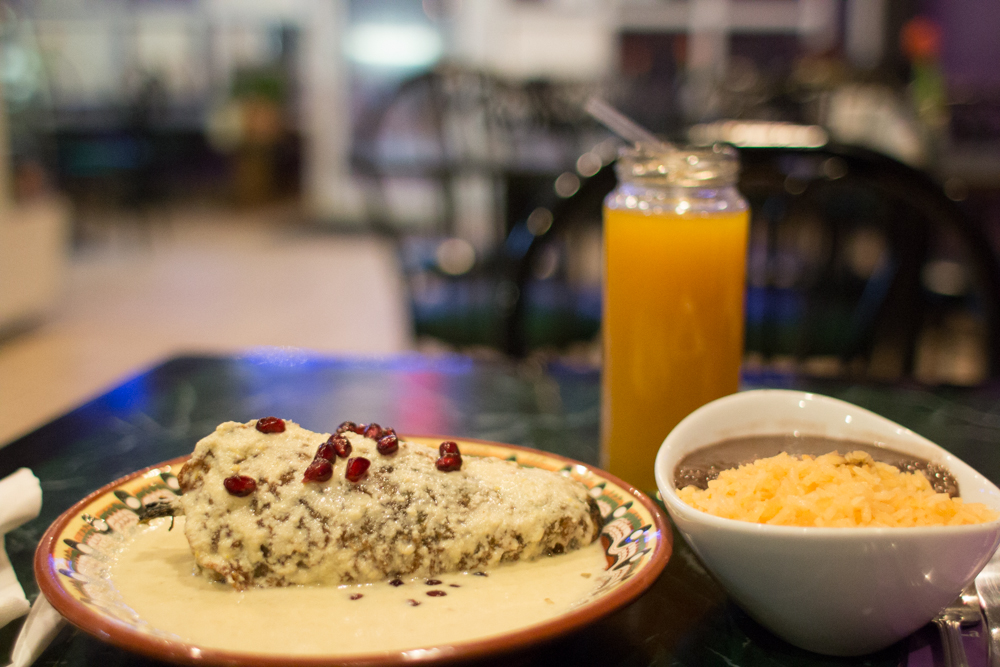
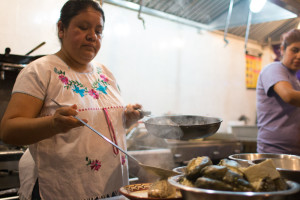
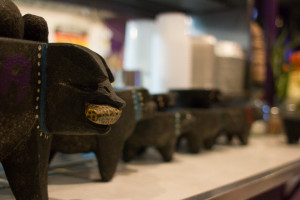
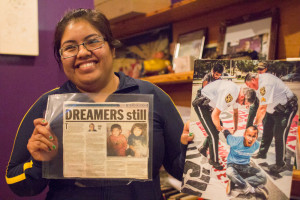
Your Comments